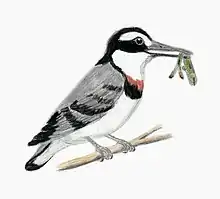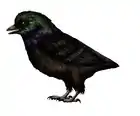| Longicrusavis Temporal range: Early Cretaceous, | |
|---|---|
| Scientific classification | |
| Domain: | Eukaryota |
| Kingdom: | Animalia |
| Phylum: | Chordata |
| Clade: | Dinosauria |
| Clade: | Saurischia |
| Clade: | Theropoda |
| Clade: | Avialae |
| Clade: | Ornithuromorpha |
| Family: | †Hongshanornithidae |
| Genus: | †Longicrusavis O'Connor et al., 2010 |
| Species: | †L. houi |
| Binomial name | |
| †Longicrusavis houi O'Connor et al., 2010 | |
Longicrusavis (meaning "long shin bird" in Latin) is an extinct genus of basal ornithuromorph bird found only at Dawangzhangzi village in Liaoning Province, China. Longicrusavis was a ground dwelling carnivore, a wader, and part of biological family Hongshanornithidae, considered to have been a dominant species in the Jehol Biota, the prehistoric Chinese ecosystem which supported them.[1] The name Hongshanornithidae represents one of China's oldest recorded cultures in the region, the Hongshan culture.[2]
Description
Longicrusavis is a ground dwelling carnivore known from the holotype specimen PKUP V1069, found from the Lower Cretaceous Yixian Formation in Liaoning Province, China.,[3] which consists of shale slab and counter slab. The skeleton is nearly complete and belongs to an adult individual, with carbonized feathers preserved in full plumage with visible colouration around the head and forelimbs.
Like the closely related genus Hongshanornis, Longicrusavis has hindlimbs that are very long relative to the forelimbs. Longicrusavis has a rostrum that is more robust than that of Hongshanornis. The skull, though broken in the individual specimen, would be roughly triangular in shape with large eye socket orbits. In lateral view, the dorsal margin of the skull is slightly concave, but not as much as the dorsal margin of the skull of Hongshanornis, where there is an abrupt constriction at the rostrum.
Although no teeth are preserved, they were likely present in the upper jaw owing to the presence of alveoli, or tooth sockets, in the premaxilla and maxilla. Otherwise, Longicrusavis is one of the closest examples to a toothless bird with an evolving beak. Hongshanornis also appears to have alveoli, despite being described as toothless when it was first named.[2] No alveoli are found in the mandible, indicating that it was likely edentulous. Longicrusavis exhibits an obvious long, thin, pointed beak.[3][4]
Comparison of the tail feathers to another similar discovery, both possessing a long fan shaped tail improving flight, suggests these to be the oldest form of bird with this type of tail.[5]
Implications
Longicrusavis is important because detailed evidence of transitioning dinosaurs to birds are rare. Specimen PKUP V1069 also gives us, in conjunction with another palaeontological discovery five years before, evidence a range of small specialised birds from the early Cretaceous, 120-130 million years ago.[5]
The holotype evidencing the discovery is held at the Beijing Institute of Vertebrate Paleontology and Paleoanthropology (IVPP) as part of a collection.
Jehol Biota
The Longicrusavis fossil was part the Jehol Biota from which is unearthed a whole range of palaeontological finds including dinosaurs, mammals, birds, fishes and invertebrates. "The Jehol Biota never fails to stop giving, and the research to be done on these fossils is virtually endless!" said O'Connor who has determined at least three evolutionary stages to divide history based on the Dabeigou (130ma), Yixian (125ma), and Jiufotang (120ma) Formation periods issuing the Longicrusavis are the earlier Yixian and Jiufotang.[5]
References
- ↑ "†Longicrusavis O'Connor et al. 2010 (bird)". Fossilworks. Retrieved 9 February 2019.
- 1 2 Zhou, Z.; Zhang, F. (2005). "Discovery of an ornithurine bird and its implication for Early Cretaceous avian radiation". Proceedings of the National Academy of Sciences USA. 102 (52): 18998–19002. doi:10.1073/pnas.0507106102. PMC 1323170. PMID 16344487.
- 1 2 O'Connor, J.K.; Gao, K.-Q.; Chiappe, L.M. (2010). "A new ornithuromorph (Aves: Ornithothoraces) bird from the Jehol Group indicative of higher-level diversity" (PDF). Journal of Vertebrate Paleontology. 30 (2): 311–321. doi:10.1080/02724631003617498. S2CID 53489175.
- ↑ Zhou, Z.; Zhang, F. (2006). "Mesozoic birds of China — a synoptic review" (PDF). Vertebrata PalAsiatica. 44 (1): 74–98. doi:10.1007/s11515-007-0001-y. S2CID 43323972.
- 1 2 3 Research Organisations (25 March 2010). "New bird fossil hints at more undiscovered Chinese treasures". Science Daily. Retrieved 9 February 2019.


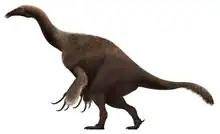

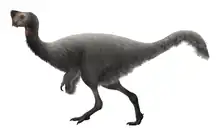
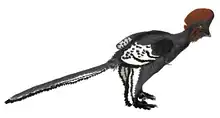


.png.webp)

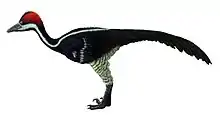
.jpg.webp)

